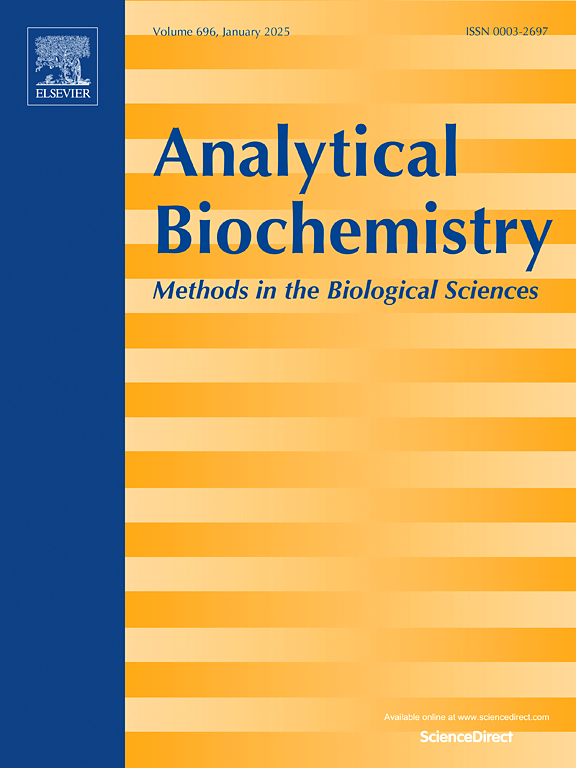Recombinase polymerase amplification for single nucleotide polymorphism-specific detection of βC variant in sickle cell disease
IF 2.5
4区 生物学
Q2 BIOCHEMICAL RESEARCH METHODS
引用次数: 0
Abstract
Sickle cell disease (SCD) comprises a group of inherited blood disorders caused by point mutations in the β-globin gene. SCD is characterized by at least one βS globin allele and a second pathologic globin variant that results in predominant formation of hemoglobin S (HbS). Early diagnosis in low-and middle-income countries is limited by the high cost and complexity of DNA-based tests. Recombinase Polymerase Amplification (RPA) is an isothermal nucleic acid amplification technique that facilitates rapid and low-cost detection of genetic mutations. While RPA primers have been developed to detect wild-type βA and βS alleles, they can also amplify the βC allele, the next most common hemoglobin variant causing SCD which requires distinct clinical management. We developed a novel allele-specific RPA fluorescent assay for selective detection of the βC allele using primers incorporating Amplification Refractory Mutation System (ARMS) and Locked Nucleic Acid (LNA) modifications. Twelve forward primers with different modifications were screened to achieve βC-specific amplification. The best-performing primer combined a single mismatch near the 3′ end with an LNA at the terminal base, enabling specific detection of βC with a limit of detection of 100 copies per reaction. Key design insights include avoiding mismatches immediately before the LNA for consistent target amplification and positioning the LNA closer to the 3′ end to achieve less sensitive amplification. This study establishes an isothermal assay for SCD diagnosis and offers systemic design strategies for SNP-specific RPA assays. These findings have important implications for expanding affordable, rapid genetic testing for hemoglobinopathies in low-resource settings.

重组酶聚合酶扩增用于镰状细胞病ßC变异单核苷酸多态性特异性检测。
镰状细胞病(SCD)是一组由β-珠蛋白基因点突变引起的遗传性血液疾病。SCD的特征是至少有一个βS珠蛋白等位基因和第二个病理性珠蛋白变异,导致血红蛋白S (HbS)的主要形成。低收入和中等收入国家的早期诊断受到基于dna的检测的高成本和复杂性的限制。重组酶聚合酶扩增(RPA)是一种等温核酸扩增技术,可以快速、低成本地检测基因突变。虽然RPA引物已被开发用于检测野生型βA和βS等位基因,但它们也可以扩增βC等位基因,这是导致SCD的下一个最常见的血红蛋白变异,需要不同的临床管理。我们开发了一种新的等位基因特异性RPA荧光检测方法,用于选择性检测βC等位基因,引物结合扩增难突变系统(ARMS)和锁定核酸(LNA)修饰。筛选了12条不同修饰的正向引物,以实现β c特异性扩增。性能最好的引物将靠近3'端的单个错配与末端碱基的LNA结合在一起,能够特异性检测βC,每次反应的检测限为100拷贝。关键的设计见解包括避免LNA之前的不匹配,以实现一致的目标放大,并将LNA定位在更靠近3'端的位置,以实现更低灵敏度的放大。本研究建立了SCD诊断的等温分析方法,并为snp特异性RPA分析提供了系统的设计策略。这些发现对于在低资源环境中扩大可负担得起的快速血红蛋白病基因检测具有重要意义。
本文章由计算机程序翻译,如有差异,请以英文原文为准。
求助全文
约1分钟内获得全文
求助全文
来源期刊

Analytical biochemistry
生物-分析化学
CiteScore
5.70
自引率
0.00%
发文量
283
审稿时长
44 days
期刊介绍:
The journal''s title Analytical Biochemistry: Methods in the Biological Sciences declares its broad scope: methods for the basic biological sciences that include biochemistry, molecular genetics, cell biology, proteomics, immunology, bioinformatics and wherever the frontiers of research take the field.
The emphasis is on methods from the strictly analytical to the more preparative that would include novel approaches to protein purification as well as improvements in cell and organ culture. The actual techniques are equally inclusive ranging from aptamers to zymology.
The journal has been particularly active in:
-Analytical techniques for biological molecules-
Aptamer selection and utilization-
Biosensors-
Chromatography-
Cloning, sequencing and mutagenesis-
Electrochemical methods-
Electrophoresis-
Enzyme characterization methods-
Immunological approaches-
Mass spectrometry of proteins and nucleic acids-
Metabolomics-
Nano level techniques-
Optical spectroscopy in all its forms.
The journal is reluctant to include most drug and strictly clinical studies as there are more suitable publication platforms for these types of papers.
 求助内容:
求助内容: 应助结果提醒方式:
应助结果提醒方式:


